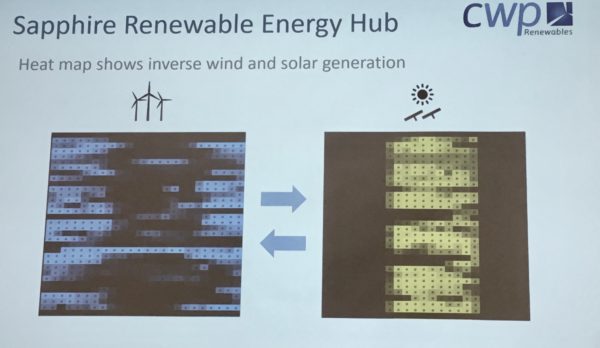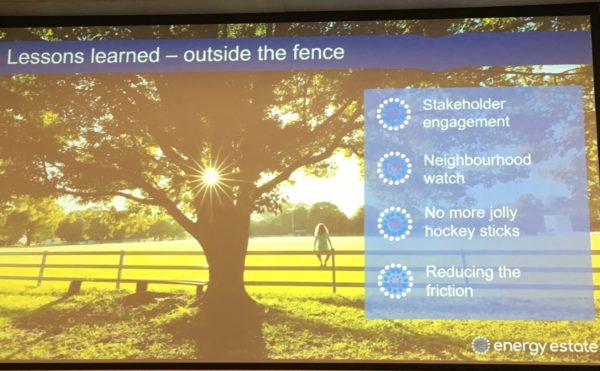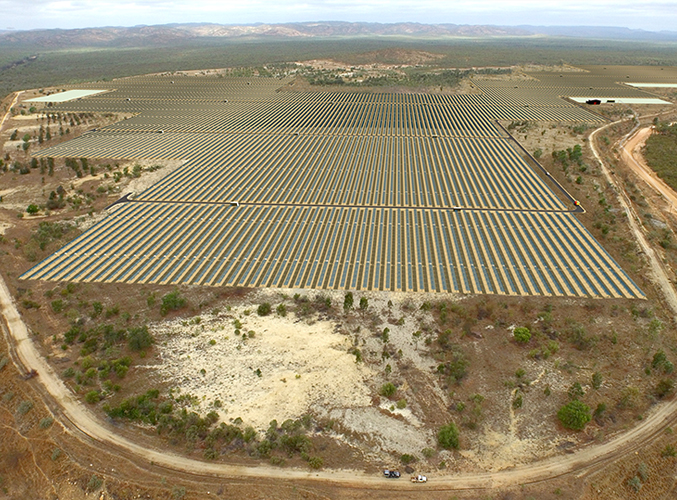Reflected in the 20 solar panels being connected to the grid each minute in Australia you might spy a gently turning forest of wind turbines, the faces of people in communities, and an as yet wobbly image of the future grid. The message from today’s Informa Commercial & Large Scale Solar Conference is that the PV industry needs to behave in a more connected way in order to get connected in future.
Matt Walden, Director of Business Development and Transactions at the Australian Renewable Energy Agency (ARENA) said first up that one of the agency’s priorities is to more clearly understand the benefits of integrating solar into “bigger portfolios of assets”, such as Kennedy Energy Park which combines battery storage, wind and solar.
“We need to better understand what those three assets can do in terms of providing a stable, dispatchable, product to market,” said Walden, who also named Genex’s integrated Kidston trio of pumped hydro, wind and solar as a project ARENA is monitoring.
Several speakers reminded the audience that “Wind and solar are not competitive”. Among them was Andrew Dickson, Business Manager at CWP Renewables, as he introduced the case study of CWP’s Sapphire Renewable Energy Hub, which has already realised a 270 MW wind project and is proposing to add up to 230 MW of PV generation, as well as an “appropriately sized” battery.
Dickson showed particularly illustrative heat maps of the evening, night-time and morning generation of wind from the wind farm, compared to the daytime generation of solar; their combined energies; and how the addition of a battery further filled in the generation gaps.

Image: CWP Renewables
“The benefit of hybridising an existing wind project is primarily around getting high utilisation of expensive assets,” said Dickson. He continued, “A substation on a 330 kV transmission line is very expensive. You really want to get maximum utilisation, particularly from the transformer, so adding solar to fill the gaps during the daytime is the obvious way to do that.”
CWP is now in the final stages of implementing large-scale community investment in Sapphire: “We see it as critical to enhancing the social license” of the project, says Dickson. The solar addition he says, then “really stands on the shoulders of the success of the wind project, and hopefully creates an asset even more valuable than wind on its own.”
Simon Currie, Principal and Co-Founder of Energy Estate, an energy consulting, advisory and services firm, brought up the subject of stakeholder engagement in the context of his session, “Solar in Australia: Lessons learned from the past two years”. In this case he wasn’t referring to the consumer or farm-hosting community, but to industry competitors — potential collaborators — who need to work together given Australia’s constrained transmission infrastructure and rapidly changing landscape of development and grid connection.
He said, “People aren’t going to like what I say, but most solar developers spend no time engaging. They might join the CEC [Clean Energy Council], they might come along to this conference, but in terms of proper stakeholder engagement, being involved in the industry, and participating with the industry — they haven’t set themselves up.”
He urged industry players to take part in the shaping of systems that will inevitably be put in place, rather than having order imposed on them. “You need to invest in people to go and sit in on AEMO forums and to work together, rather than thinking you’re in a fight … over grid or other issues.”
Currie says the energy industry as a whole has also been poor at recognising how other proponents are positioning themselves and where opportunities for collaboration and negotiation lie. He too brought up the subject of maximising the use of infrastructure — by sharing the use of substations, and co-locating to avoid duplicated grid connections.
“We need to move to system-wide strengthening, not say, ‘I did well, beggar my neighbour’”, when hooking up to the grid.
At Walcha Energy Project on the New England plateau, a combined solar, wind and pumped hydro development by Energy Estate and MirusWind, the potential is to generate more than 4 GW of energy. Currie says “We are earnestly pushing the concept of a hub. We can afford to shrink to fit and cohabitate and work with other developers.”
But so far such co-operation has been stymied because the concept seems foreign in the Australian industry. He says here it’s more likely “a 500 MW solar farm will cut into one of the arteries of the transmission system, and a wind project then has to cut in another 20 kilometres down the line”.
Currie says electrical engineers are aghast at such self-serving activity, and cites the US as a market much more disposed to successful hub development, which has “led to better system outcomes”.
He likens the change in mindset required to Neighbourhood Watch a coordinated awareness and desire to act in the shared interest.

Image: Energy Estate
In a neighbouring room at Sydney’s Swissôtel, Informa is concurrently running the Pumped Hydro Energy Storage Conference. There, Fiona Orton, Future Grid Manager of TransGrid, the New South Wales transmission network operator, is talking about the Renewable Energy Zones identified by the Australian Energy Market Operator’s Integrated System Plan, saying, “We have to have an integrated approach,” to installing all the renewable energy Australia will need to replace retiring coal assets in coming decades.
She reminds the audience that it takes seven years to develop a new transmission line, and that current connection interest from renewable projects is outstripping network capacity.
Renewable development, she says, needs to be clustered where capacity is strongest. It needs to consider not only sun and wind resources, but existing infrastructure, appropriate land use and existing community support.
“We’re moving towards a far more centralised, controlled, orderly system,” Currie concurs, “whether people like it or not.”
This content is protected by copyright and may not be reused. If you want to cooperate with us and would like to reuse some of our content, please contact: editors@pv-magazine.com.









By submitting this form you agree to pv magazine using your data for the purposes of publishing your comment.
Your personal data will only be disclosed or otherwise transmitted to third parties for the purposes of spam filtering or if this is necessary for technical maintenance of the website. Any other transfer to third parties will not take place unless this is justified on the basis of applicable data protection regulations or if pv magazine is legally obliged to do so.
You may revoke this consent at any time with effect for the future, in which case your personal data will be deleted immediately. Otherwise, your data will be deleted if pv magazine has processed your request or the purpose of data storage is fulfilled.
Further information on data privacy can be found in our Data Protection Policy.